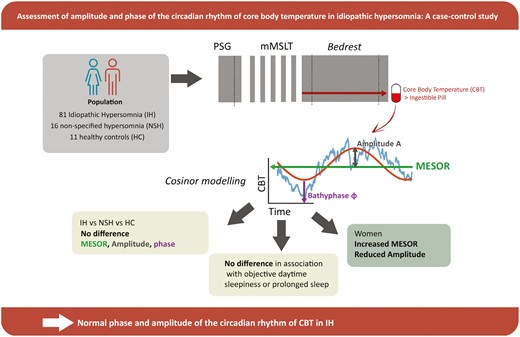-
Views
-
Cite
Cite
Tugdual Adam, Lucie Barateau, Jérôme Tanty, Yves Dauvilliers, Absence of dysregulation in amplitude and phase of circadian rhythm of core body temperature in idiopathic hypersomnia: a case–control study, Sleep, Volume 48, Issue 3, March 2025, zsae246, https://doi.org/10.1093/sleep/zsae246
Close - Share Icon Share
Abstract
To investigate the amplitude and phase of the circadian rhythm of core body temperature (CBT) via the continuous measure of the gastrointestinal temperature in participants with idiopathic hypersomnia (IH), non-specified hypersomnia (NSH) compared to healthy controls (HC) in a constant routine standardized bedrest (BR) protocol.
Consecutive participants evaluated in a National Reference Center for Rare Hypersomnias benefited from an extensive evaluation with one-night polysomnography, followed by a modified Multiple Sleep Latency Test (mMSLT), and a continuous 32-hour BR recording in standardized conditions. CBT was recorded via a telemetry pill (e-Celsius) during the BR, modeled by a Cosinor, with extraction of MESOR, amplitude, and phase. Participants with IH, diagnosed according to the International Classification of Sleep Disorders-3, were compared with participants with NSH (complaint of hypersomnolence but normal mMSLT and BR), and HC. Participants were divided into four groups based on their mMSLT mean sleep latency (mMSLT+,≤8 minutes) and their BR total sleep time (BR+, ≥19 hours).
A total of 108 participants (80% women, 28.3 ± 7.8 years old) were included in the analyses, 81 IH (83% women), 16 NSH (75% women), and 11 HC (64% women). Cosinor amplitude and phase of CBT did not differ between IH, NSH, and HC, nor in the subgroup analysis (37 BR+/mMSLT+, 35 BR+/mMSLT−, 9 BR-/mMSLT+, 27 BR-/mMSLT−). No difference in chronotypes was observed between groups. Women had a greater MESOR and reduced CBT amplitude compared to men.
The circadian rhythm of CBT showed no difference in amplitude or phase between IH, NSH, and HC, and was not related to prolonged sleep time or objective daytime sleepiness.










Comments